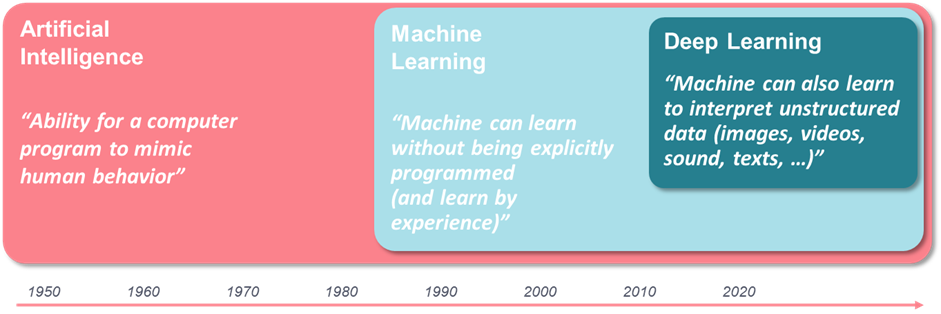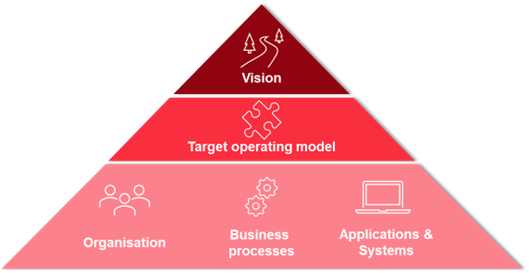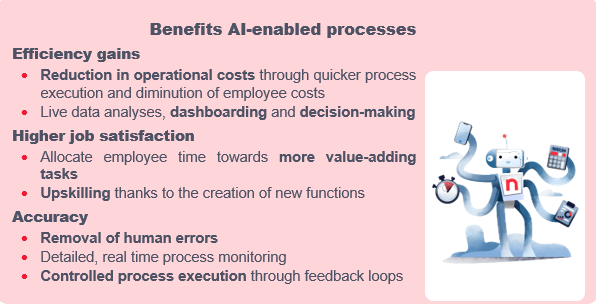We can assume that everyone has heard the term AI or Artificial Intelligence, but do we all have the same understanding? The English dictionary gives us the following definition:
“The branch of computer science involved with the design of computers or other programmed mechanical devices having the capacity to imitate human intelligence and thought.”
Or in other words, computer programs that can take human-like decisions when programmed to do so. Over the last decades, this technology has made important progress in its accessibility for all industries. AI solutions are no longer developed only by and for the high-tech companies...
Over time, AI technology has significantly evolved. Major evolutions typically take place during periods in which AI gains renewed interest from researchers and industry, the so called “AI Summers”. Until now we can speak of 3 major evolutions.

The first developments of Artificial Intelligence date back from the 50’s, when scientists managed to code the ability to imitate human behaviors into computers. This would be the first form of “intelligence” given to a software program.
The next evolution took place thirty years later and is referred to as Machine Learning. This technology equips machines with techniques allowing them to learn from examples without being explicitly programmed. In initial subsets of Machine Learning, computers could only learn under human supervision: every time the machine ran into an issue, a human would solve the issue and the machine would then remember the solution.
Deep learning is the most recent development in AI. It trains machines to learn how to perform tasks by learning from experiences. Machines are then able to improve themselves in performing given tasks by leveraging the outcome of previous runs of the same tasks. With this technology, human supervision becomes less and less necessary as the machine quickly gains in autonomy. However, the tasks humans perform remain essential in the machine’s learning process as they are in charge of supervision and feedback. Those human interventions enable the machine to keep learning in order to further improve the process.
Three enablers made AI accessible
If the technology is not new, why did it
take so long to enter the market?
Three factors turned out to be strong enablers for the technology to
reach its potential and to become applicable to many sectors and organizations:
- Data is ubiquitous in almost every industry, even if often latently. Until recently, AI was reserved to a select few who were able to generate and process zillions of data. Nowadays almost every device is connected, and each action generates data that can be collected, processed and then used at an affordable price. Therefore, collecting, storing and organizing data around business needs is a now a priority in any business.
- Algorithms are the foundation of every computer program. They tell the computer what problems to solve, and how to solve them. Thanks to algorithms, the emergence of new machine learning technologies and related training models became possible. With the increased effectiveness of training models, data quality turns out to be more important than quantity to implement AI solutions. Moreover, while the capability to design algorithms remains relatively scarce within organizations, more and more AI integrators are entering the market. Consequently, AI programming skills are within reach.
- Computing power has increased tremendously since the foundation of IBM. More specifically, in accordance with the Law of Moore (the cofounder of Intel), the number of transistors on digital chips doubles every two years. This implies the consistent growth in computer power. What is more is that the cost of 1GB (Gigabyte) of digital storage has declined with a factor x350 from €277,00 to €0,79, making computing power very accessible. Cloud computing allows a huge reduction in infrastructure costs while juicing up information processing.
The impact of these developments on the accessibility of AI for companies is tremendous. Today, Artificial Intelligence is up for grabs since 1) every company generates enough data to feed the system 2) competencies to develop algorithms are readily available and 3) enough computing power is available at every company.
But when is AI the right solution to improve your processes?
Let’s review the benefits you can expect from AI-enabled process automation.
To take advantage of these benefits, it is important to carefully select the process you wish to automate. The list below contains the success factors for process automation with AI. Checking every box is not necessary to obtain a positive business case since the importance of one dimension could also tip the scale. Nevertheless, AI will be an advisable solution the more your processes:
- Include time-consuming, repetitive actions and time-critical decisions
- Are prone to human errors
- Know a high volume of occurrences
- Use unstructured data as inputs:
- Mix of physical and digital
- Variable inputs (e.g., multiple or changing templates)
- Unfit for simple decision making (yes/no decisions)
- Bring together disintegrated systems using the same data
- Does not rely on judgement based or creative decisions
Concrete applications of AI
You might now be wondering what is in it for your company.
To help you realize how much potential lies in this technology, let’s share a few real-life examples to illustrate how AI has already brought business value to companies in Belgium.
With the support of one of our partners for AI projects, companies have already been able to:
· Detect more than 80% of invoicing errors
Some sectors (such as the healthcare industry) imply a complex billing process that can lead to costly billing errors. By implementing an AI solution that scans the medical services of a hospital, more than 80% of errors were quickly detected and thus corrected.
· Improve the quality of a production chain and reduce waste
AI was used to spot microcracks (hardly visible to the naked eye) in gas mixers within 4 seconds, and to immediately remove defective parts from the production chain. This prevents the valves from breaking during assembly and led to improved quality, reduced waste and shorter lead times, thanks mainly to the removal of reworks.
· Improve the sorting of a waste facility and monitor quality in real time
AI helped set up a dashboard that enables the client to monitor the quality of the sorting process in real time, and to take corrective measures when the expected degree of purity, namely 99%, is not reached. The sorted waste is then sold to a buyer with a highly decreased risk of refusal or return.
These cases illustrate how AI has quickly evolved from myth to reality for companies through relevant applications of this emergent technology to core business operations.
Make AI your reality today
To make sure your company reaps the benefits of intelligent process automation, your project should be nested in an operational excellence roadmap that translates strategic objectives into tangible results.
Defining the end goal
First, you should have a clear vision of the desired outcome and benefits, and how those will contribute to the realization of your company’s strategy. Declining this vision into a Target Operating Model (TOM) is essential to steering your transformation efforts in terms of what you should do, its feasibility, and related impacts on the organization’s operational dimensions.

Aligning your operational dimensions
The central dimension is the business processes. Moving your current processes to the desired state will be easier if you have documented processes. Once documented, your business processes should be improved or re-engineered, to ensure your AI solution will be plugged on a strong base.
Intimately linked to your business processes is technology. Your infrastructure, applications, and functionalities needed to enable your process improvement goals. When going for AI-enabled process automation, you should give specific attention to your data, as these will be used to train your model. That means ensuring sufficient data quality, generation and management.
Thirdly, and no less importantly, organizational changes will occur as you implement your new processes. A cultural shift usually comes along with process automation. New ways of working will be introduced as your people will need to learn to trust software to execute tasks they traditionally took care of. In the meantime, freed up employee time will be reallocated towards more value adding tasks. New roles and related skills will emerge, together with accountability and reporting structures.
How do you eat an elephant? You slice it…
This transformation with all its aspects might seem overwhelming at first. That is why it should be structured in a process excellence roadmap, taking priorities and interdependencies into account. An extra piece of advice is to start small, preferably with a new project or on a less significant part of your operations. This will allow your company to familiarize progressively with Artificial Intelligence in a controlled environment and to fine-tune your business case. With experience, you will be able to scale your solution and reap incremental benefits.
Pull up a red chair
Whether
you wish to explore the opportunities AI can bring to your operations, or you
would first like to start with an introduction to AI workshop, our team will be
delighted to discuss it with you.
